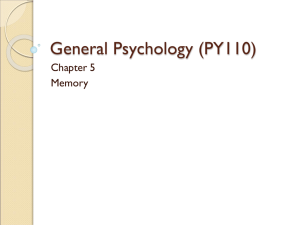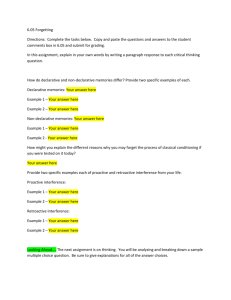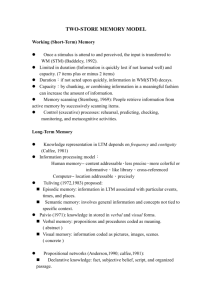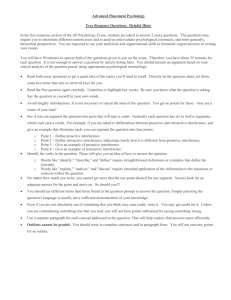Improving Memory PowerPoint
advertisement
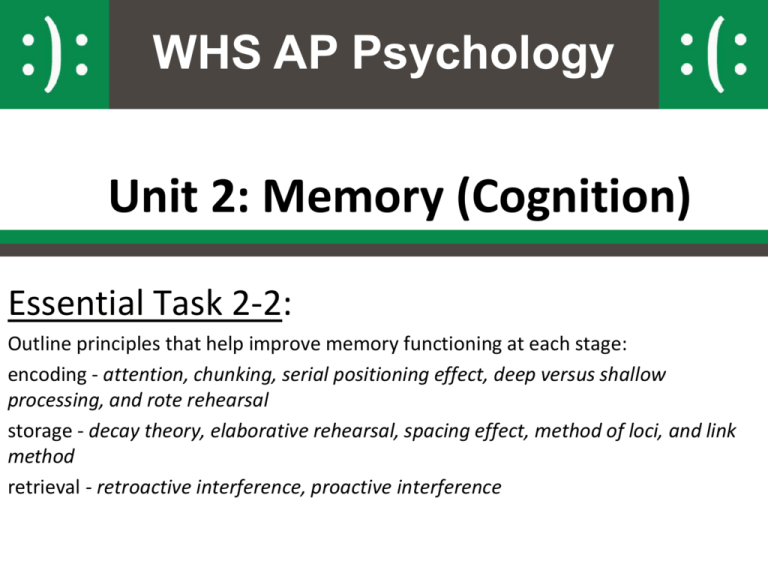
WHS AP Psychology Unit 2: Memory (Cognition) Essential Task 2-2: Outline principles that help improve memory functioning at each stage: encoding - attention, chunking, serial positioning effect, deep versus shallow processing, and rote rehearsal storage - decay theory, elaborative rehearsal, spacing effect, method of loci, and link method retrieval - retroactive interference, proactive interference Information Processing Model 1. Encoding gone Long Term Memory 2. Storage 3. Retrieval All the rest We are here External Stimuli Sensory Registers Retrieval Short Term Memory Essential Task 2-2: Outline • Improving Encoding – – – – – • Improving storage – – – – • attention chunking serial positioning effect Schemata and Hierarchy deep versus shallow processing decay theory spacing effect Rote rehearsal vs. elaborative rehearsal Mnemonics like method of loci and link method Retrieval – – – – – – Retrieval Cues and Priming Situational factors State dependent Allow for Parallel Processing Overcoming retroactive interference Overcoming proactive interference Improving Encoding Outline Attention? Pay Attention • You can consciously decide to pay attention to something. • If you don’t pay attention it won’t enter your STM and never get to your IPM. Outline Chunking • The grouping of information into meaningful units for easier handling by short term memory. • M-S-N-N-A-S-A-C-I-A-C-O-M Or • MSN NASA CIA COM Outline Conduct Inclusive Memory Activity Now Serial Position Effect Outline • People tend to recall the first items (primacy effect) and last items (recency effect) in a list • Demonstrates how short- and longterm memory work together • Primacy effect reflects long-term memory • Recency effect reflects short-term memory Serial Position Effect Outline Schemata • A schema is a set of beliefs or expectations about something based on past experience • Incoming information is fit with existing schemata – (concept maps) • Schemata can also influence the amount of attention paid to a given event • Reconstruction – Memories can be altered with each retrieval – We do this to keep the schemata of our self and our environment Outline Hierarchy Complex information broken down into broad concepts and further subdivided into categories and subcategories. Encoding Summarized in a Hierarchy Conduct Processing Activity Now Outline Deep Versus Shallow Processing Deep Processing analyzes meaning Shallow processing does not Outline Improving Storage Outline Decay Theory • The decay theory argues that the passage of time causes forgetting. • The longer information is not accessed, increases the chances of forgetting it. Outline Spacing Effect •Distributing rehearsal (spacing effect) is better than practicing all at once. You can memorize a poem a lot easier if you break it down into 5 parts over 5 days instead of all at once. Maintaining Long-Term Memory • Rote rehearsal – Repetition can result in long-term memory – Only effective if there is intent to learn material – Example: What does a penny look like? Outline Maintaining Long-Term Memory • Elaborative rehearsal – Process of relating new information to information already stored in memory – Meaning is assigned to new information and then linked to as much existing knowledge as possible – Hence Psych Immersions Outline Link Method • First imagine a silly, memorable image that represents the type of list you want to remember. Also include in this image the first item on the list (see below for example). This image is your header for the list. • Think of another silly, memorable image that links the first item on the list to the second item and so on. Outline Method of Loci • In this technique the subject memorizes the layout of some building, or the arrangement of shops on a street, or any geographical entity which is composed of a number of discrete loci. When desiring to remember a set of items the subject literally 'walks' through these loci and commits an item to each one by forming an image between the item and any distinguishing feature of that locus. Outline Improving Retrieval Outline Retrieval Cues Memories are held in storage by a web of associations. These associations are like anchors that help retrieve memory. water smell fire smoke Fire Truck heat truck red hose Priming To retrieve a specific memory from the web of associations, you must first activate one of the strands that leads to it. This process is called priming. Where and when matters • Situational factors – Recall of information is better if environment is the same as when information was learned • State-dependent memory – Recall of information is better if person is in the same physiological state as when information was learned Parallel Processing • Tip of the Tongue Phenomenon is when you can almost recall something, but can’t quite get it. • If you leave it your brain will continue to work on this problem eventually surfacing with the answer. • Thus you later yell out the name of the actor and everyone looks at you like you are odd. Interference • Retroactive interference – Occurs when new information interferes with information already in memory – Retro means old – In this term the old information is being tested – Thus the new information is doing the interference. Outline Try remembering the following number • 8132163 • Ok that was easy because nothing interfered with you. Outline Now let’s try some interference • 4982631 • First, consistent with cognitive dissonance theories, we are able to induce optimism or pessimism with the initial (random) wage assignment. With respect to the first-stage task, this implies that we can successfully manipulate one’s ability-beliefs in the lab. Secondly, subjects who received this low piece-rate in stage one were willing to accept significantly lower offers in a second-stage ultimatum game. This finding is striking, demonstrating the presence of both belief manipulation and spillovers of those beliefs into behavioral outcomes in an unrelated and distinct experimental environment. Outline Try remembering the following number • 5614982 • 92589386 Outline Retro-active Interference • The last two were examples of retroactive interference • In each one, it was the OLD (retro) information that was being tested. • The last trial was the hardest because it overloaded your modality. • What type of music should you listen to when you write an essay? Outline Retroactive Interference Sleep helps prevent retroactive interference. Therefore, it leads to better recall. Outline Interference • Proactive interference – This is when new information is being tested. – The old information already in your LTM interferes. – It is tough to teach an experienced show dog new tricks. – Psychologists have found that recall of later items can be improved by making them distinctive from early items. For example, people being fed groups of numbers to remember did much better when they were suddenly fed a group of words instead. This is called release from proactive interference Outline I need a volunteer that knows their colors. • Don’t read the words, just say the colors they’re printed in and as fast as you can • This is called the stroop effect Outline Red Yellow Green Blue Red Blue Yellow Green Blue Red Interference • When you look at the words you see both its color and meaning. • When they are in conflict you must make a choice • Experience has taught you that word meaning is more important than color so you retrieve that information. • You are not always in complete control of what you pay attention to. Outline Schemata • A schema is a set of beliefs or expectations about something based on past experience • Incoming information is fit with existing schemata • Schemata can also influence the amount of attention paid to a given event • Reconstruction – Memories can be altered with each retrieval – We do this to keep the schemata of our self and our environment Outline


